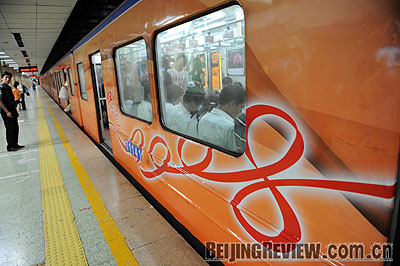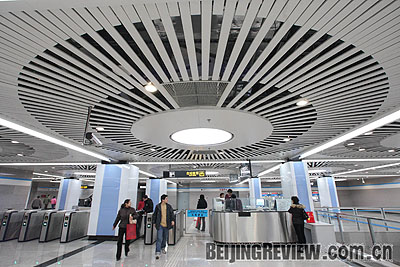|
|

READY TO GO: A subway train with the logo of the 2008 Olympics departs from a station. As the host city of the Games, Beijing built more subways to meet demand for the big event (LI YONG) |
At the end of July, shortly after Beijing No.10 Subway Line opened, Shi Yi, who lives near the new route, bought a traffic card. It was a bold move for Shi, who was switching from his car to public transport.
"There are more people taking subways after the ticket price was lowered," he said. "And taking the subway is just like doing physical exercise since it is very crowded at peak hours."
According to the city's plan, by 2015, the total length of subway line in Beijing will be 561 km and the number of subway lines will reach 19.
Currently, some roads close to subway stations are hit by daily traffic jams. In order to solve this problem, the government has made several commitments. It aims, within the near future, to ensure that within Beijing's third ring road people only need to walk for an average of 1 km to reach the nearest subway station, that the density of the rail network within the second ring road will reach 1.08 km per square km, and that within the fifth ring road its density will be 0.51 km per square km.
Subways are playing an increasingly important role in connecting the different districts of Beijing, such as Zhongguancun (the hi-tech area), Financial Street, West Railway Station, South Railway Station, the Olympic Park and the Central Business District. Even some suburban districts, including Changping, Shunyi and Mentougou, were now connected by rail transit.
|

EXPANSION: Sipinglu Station on Line 8 in Shanghai, which is one of the three new subway lines put into trial operation on December 29, 2007 |
This year, subways in Beijing, the host city of the Olympics, expanded at an unprecedented rate. In the next two years, Beijing will invest 120 billion yuan ($17.4 billion) to 150 billion yuan ($21.75 billion) to stimulate domestic demand. A big part of the investment, about 90 billion yuan ($13.05 billion) will go to the construction of rail transit.
Dream come true
"When Shenyang Municipal Government announced in August 2005 that a subway-construction plan had received State Council approval and would start by the end of October that year, my father wrote to me saying it was a dream come true," said Cai Duomao, who was born in Shenyang.
|
